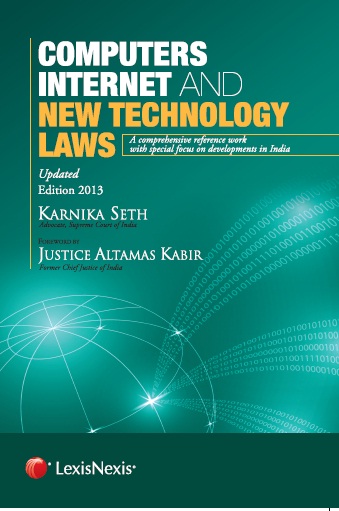Domain Names
Author: Karnika Seth
DOMAIN NAMES
This article is a basic guide to understanding the concept of domain names on the internet and briefly discusses the Domain Nmae dispute Resolution policy and the famous Tata case, one of the first domain name disputes in the Indian context .
What is an IP address?
The Internet is a network of computers. Each computer on the said network has its own distinct entity and presence. That is the reason why every computer is given a distinct Electronic Address called the Internet Protocol address or in short IP address. This IP address is given by numerical values like 202.54.15.75. The IP address is just like any telephone number which identifies a particular computer on the Internet.
What is a Domain Name ?
Since it is not possible to remember each and every numerical value of an IP address, the system of domain names evolved. Internet domain names, in a common man’s language, are used as an easy-to-remember alias which point to a specific IP address. The dominant purpose of the domain name is simply to provide an easy method for remembering another’s electronic address. It’s a unique name used to identify, among other things, a specific Web site. Thus a typical domain name would be http://www.indiainfoline.com.
What are the components of a Domain Name ?
Any domain name consist of two components, namely the top level domain name(TLD) and a second level domain name. Thus in the said example, http://www.indiainfoline.com, “.com” would be the top level domain name while “indiainfoline” would be second level domain name.
What are the categories of Top Level Domain Names (TLDs)?
As on date, there are two categories of top level domain names. In the first category comes the domain names .com, .net, .org, .edu. When the system of registering domain names began, the norms were that the .com name is to be given to commercial organizations, while others such as .org, .net, .gov and .edu are to be assigned to non-commercial organizations, network providers, government agencies and educational institutions respectively. However, as time has passed, due to the enhanced volumes of domain name registrations, the said norms have been abandoned and today anyone can, without any restriction of any kind whatsoever, can register any domain name.
The second category of top level domain names is the country code TLDs denoted by a two letter country code. For instance, the top level domain name for India is .in. The responsibility for assigning the same is given in each country to a specified country domain name registrar. In India, the TLD.in is registered by NCST at Bombay.
Who registers Domain Names ?
The domain names were initially registered by Network Solutions only, who had the sole monopoly to register the said TLDs. This monopoly of Network Solutions continued for many years and only in 1999, the Internet Corporation Assigned Names and Numbers (ICANN) allowed other accredited registrars to register domain names. Today there are more than 100 registrars with whom one can register a TLD.
What is the unique feature of Domain Names ?
The unique feature of domain names is that the said domain names are given on “first come, first served” basis. This feature of domain names gives rise to numerous legal issues and disputes. Thus the important thing in domain names registration is speed. To take an example, the domain name www.microsoft.org was available and was registered by Amit Mehrotra much before Microsoft Corporation could think of it. This led to numerous ticklish legal issues. Microsoft Corporation, despite having the trademark Microsoft, could not get the domain name www.microsoft.org because of the “first come, first served” criteria of domain name registration.
ICANN – UNIFORM DOMAIN NAME DISPUTE RESOLUTION POLICY(APPROVED BY ICANN ON 24.10.1999 )
This is binding on registrants today.
BASIC FEATURES
1. Registrars receiving complaints concerning the impact of domain names they have registered on trademarks or service marks will take no action until they receive instructions from the domain name holder or any order of a court, arbitrator or other neutral decision maker deciding the parties dispute.
2. Exception to the above are cases of Cybersquatting , Cyberpiracy and other bad faith registration. In these cases the complaining party can invoke a special administrative procedure to resolve the dispute .
3. Neutral persons selected from panels established for it decide .
4. Procedure is handled on line – takes less than 45 days – costs about Dollar thousand fees to be paid to entities providing the neutral person.
5. Parties to disputes can also go to court to resolve their dispute or contest the outcome of the procedure.
6. Every ICANN Registrar has agreed to adhere to the dispute resolution policies that ICANN adopts under its established consensus procedures.
APPROVED DOMAINNAME DISPUTE RESOLUTION SERVICE PROVIDERS
ICANN has approved DNS resolution providers and two of the most important providers are described below-
1. WIPO
WIPO arbitration and mediation center and ICANN awarded 200-CPR award for excellence in ADR for it's Domain name dispute resolution service.
Resolves disputes -both g TLD and ccTLDs-effective from 1DEC'99
It framed the UDRP which was adopted by ICANN on26 aug '99
The center also renders the Domain name Advisory Services.
After the success of First WIPO Internet Domain Name Process now it has undertaken the second process for the protection of recognized identifiers other than trademarks eg. Geographical indicators or names of celebrities,etc.
Also it has initiated anew program-WIPO ccTLDs program- for the protection ofIntellectual property at the level of ccTLDs.
2.NATIONAL ARBITRATION FORUM
IT is a nationwide network of former judges,litigators,law professors,etc.
Forum conducts Arbitration-the binding resolution of adispute under aUniform code of procedure.
Effective from 23Dec'99
It also gives effect to UDRP policy,Rules for UDRP and its supplemental rules.
THE TATA CASE
The domain name “tata.org” has been legally won by Tata Sons Ltd. In a recent decision dated 4.4.2000,the WIPO Arbitration and Mediation Center in its administration panel decision of even date has held that the domain name “tata.org” standing in the name of The Advanced Information Technology Association, Mumbai should be transferred to the complainant being Tata SonsLtd.
FACTS
In the present case, the complainant, Tata Sons Ltd., filed their complaint with WIPO Arbitration and Mediation Centre on 19.2.2000 under the Uniform Domain Name Dispute Resolution Policy, Rules and supplemental rules made thereunder. The respondent in the case namely The Advanced Information Technology Association, Mumbai was duly served by email, facsimile and by courier service. The respondent did not choose to contest the complaint and as such the respondent was proceeded ex-parte.
REASONING ADOPTED AND DECISION
The WIPO Center came to the conclusion that :
The name/mark TATA is a “well-known” mark and that the said mark has been granted protection by means of various orders passed by various courts in India.
The mark/name TATA is synonymous with quality products and the same signifies a sense of reliability.
Since the respondent belongs to the same city as that of the complainant, the respondent is obviously aware of the long standing, enormous reputation of the name TATA and has adopted an identical domain name.
The respondent is merely “hoarding” the said domain name as is clear from the fact that though the domain name was registered about 3 years back, the same had not been activated till date.
Even if a website under the domain name had been activated, in the facts and circumstances of the case, it would be still constitute dishonest adoption and misappropriation.
The respondent’s domain name “tata.org” is identical to the trade mark TATA in which the complainant has rights and that the respondent has not legitimate interest in the said domain name.
The registration of the domain name “tata.org” is a “bad faith registration” as potential customers would be induced to subscribe to the services of the impugned websites or to deal in some matter with the respondent believing them to be licensed or authorized by or having a direct nexus or affiliation with or endorsed by the complainant.
SIGNIFICANCE OF DECISION
The judicial principles of “hoarding”, “dishonest adoption” and “misappropriation of domain name” as spelt out by this judgement are likely to have a far reaching consequence for further domain name dispute litigations in the country.
Establishes another important principle in this emerging field of law that if the cybersquatter is based in the same city in which the complainant is also based or has a presence there in, then it has to be presumed that the cybersquatter is and would be aware of the reputation of the name /trademark/businessmark/ housemark/ corporate name of the complainant when he adopts an identical domain name.
That the operation or otherwise of a website, under the said domain name, would not change the factum of coming to the conclusion of dishonest adoption and misappropriation of the domain name.been made as a very sound basis by the WIPO Centre for arriving at the conclusion about the recognition of the complainant’s rights in the impugned name/trademark/businessmark/ housemark/corporate name.














